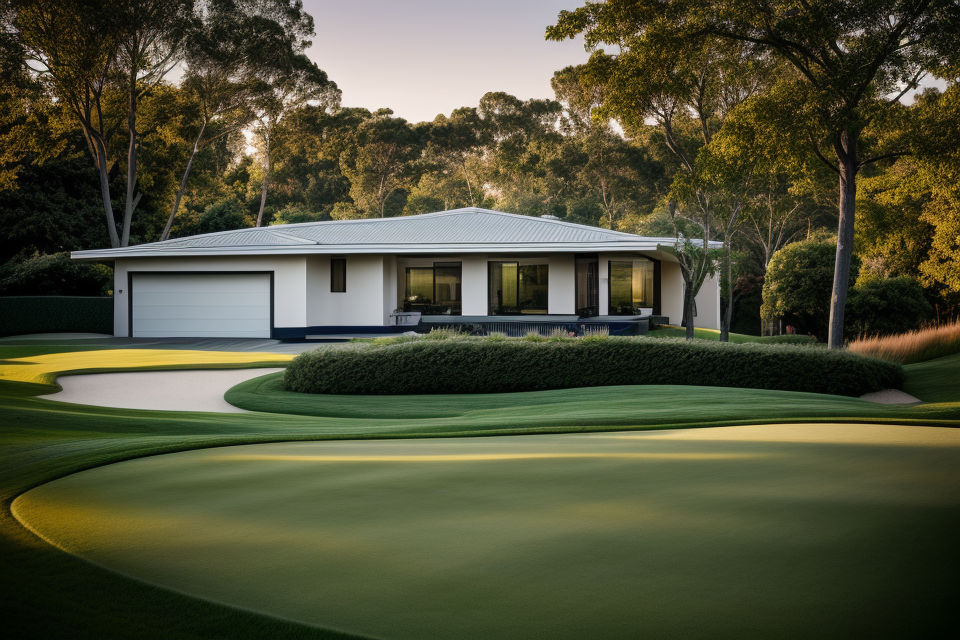
Are you considering investing in a home on a golf course? This topic has been a subject of debate for many, with some arguing that it’s a smart financial move while others claim it’s not worth the hype. Golf course homes have become increasingly popular over the years, offering not only a beautiful view but also a luxurious lifestyle. However, the question remains – is investing in a home on a golf course a wise decision? In this article, we’ll explore the pros and cons of this type of investment, helping you make an informed decision.
Investing in a home on a golf course can be a smart financial move for some individuals, but it ultimately depends on personal circumstances and financial goals. For those who enjoy golfing and are looking for a luxury property, a home on a golf course can provide a unique and desirable living experience. However, it’s important to consider the potential drawbacks, such as higher costs associated with maintenance and property taxes, as well as the potential for decreased property value if the golf course were to close. Additionally, the returns on investment may be lower compared to other types of real estate investments. Ultimately, it’s important to carefully weigh the pros and cons and do thorough research before making a decision.
Factors to Consider When Investing in a Home on a Golf Course
When considering investing in a home on a golf course, there are several factors to take into account. These include:
- Location: The location of the golf course home is a crucial factor to consider. The property’s proximity to amenities, schools, and job opportunities can affect its value and desirability.
- Golf Course Quality: The quality of the golf course can also impact the property’s value. Well-maintained courses with good facilities can increase the home’s value, while poorly maintained courses can decrease it.
- Maintenance Costs: Investing in a home on a golf course also means taking on the responsibility of maintaining the property and the golf course. This can include costs such as landscaping, irrigation, and equipment maintenance.
- Homeowner’s Association Fees: Many golf course communities have homeowner’s associations that require members to pay fees for the upkeep of the common areas and facilities. These fees can vary widely and should be taken into consideration when budgeting for the investment.
- Potential Rental Income: Golf course homes can be attractive to renters, especially those who enjoy golfing. Considering the potential rental income from the property can help offset the costs of maintenance and homeowner’s association fees.
- Potential Resale Value: Finally, it’s important to consider the potential resale value of the property. Homes on well-maintained golf courses in desirable locations can appreciate in value over time, making them a smart financial move in the long term.
Proximity to Amenities
Convenience and Accessibility
One of the key factors to consider when investing in a home on a golf course is its proximity to other amenities. This can include access to shopping centers, restaurants, schools, and other essential services. When evaluating the convenience and accessibility of a property, it’s important to consider the distance to these amenities, as well as the ease of transportation and access. Homes located in close proximity to these amenities tend to be more desirable, as they offer greater convenience and ease of living. Additionally, properties that are well-connected to transportation networks and have easy access to major roads and highways are typically more valuable and desirable.
Lifestyle and Recreation
Another factor to consider when investing in a home on a golf course is the lifestyle and recreational opportunities it offers. Golf courses often provide access to a range of recreational activities, including golfing, tennis, swimming, and other outdoor pursuits. Homes located near golf courses often have access to these facilities, as well as access to clubhouses and other social events. For individuals who enjoy an active lifestyle, living on a golf course can provide a range of benefits, including access to fitness facilities, social events, and outdoor recreational activities. Additionally, properties that offer access to these amenities tend to be more desirable and can increase in value over time.
Property Value Appreciation
When considering whether investing in a home on a golf course is a smart financial move, one of the primary factors to evaluate is the potential for property value appreciation. The value of a property on a golf course can be influenced by various factors, including its location, the quality and reputation of the golf course, and the overall real estate market.
Location and Demographics
The location of a home on a golf course can play a significant role in its potential for property value appreciation. Homes located in desirable areas with easy access to amenities, shopping, and dining options tend to appreciate in value more quickly than those in less desirable locations. Additionally, the demographics of the area can impact the desirability of the location, with areas with a high concentration of affluent individuals often experiencing more rapid appreciation in property values.
Golf Course Quality and Reputation
The quality and reputation of the golf course on which the home is located can also impact its potential for property value appreciation. Golf courses that are well-maintained and have a strong reputation for offering a high-quality golfing experience tend to be more desirable to potential homebuyers, which can increase the value of homes located on the course. Additionally, the availability of other recreational activities in the area, such as parks or lakes, can also impact the desirability of the location and contribute to the appreciation of property values.
It is important to carefully evaluate the location and the quality of the golf course when considering investing in a home on a golf course. Homes located in desirable areas with well-maintained golf courses tend to appreciate in value more quickly than those in less desirable locations or those with lower-quality golf courses.
Maintenance and HOA Fees
When considering the financial viability of investing in a home on a golf course, it is essential to assess the potential costs associated with maintenance and homeowners’ association (HOA) fees. These fees can have a significant impact on the overall financial return on investment and should be carefully evaluated before making a purchase.
Long-term Costs and Budgeting
Investing in a home on a golf course may involve higher maintenance costs due to the upkeep of the landscaping, golf course infrastructure, and common areas. It is crucial to evaluate the long-term costs associated with these expenses and ensure that they are budgeted for adequately.
Some factors to consider when evaluating long-term costs include:
- The condition of the golf course and associated infrastructure
- The frequency and cost of maintenance tasks
- The likelihood of future maintenance or repair expenses
- The financial stability of the HOA managing the course
It is essential to consider these factors when determining whether the investment is financially viable and to budget accordingly.
Influence on Property Value
Maintenance and HOA fees can also influence the property value of a home on a golf course. Well-maintained common areas and a well-managed golf course can positively impact the value of surrounding properties. On the other hand, neglected or poorly managed courses can negatively impact property values.
It is essential to consider the potential impact of maintenance and HOA fees on the property value of a home on a golf course when making an investment decision. Evaluating the potential for appreciation or depreciation in property value can help determine the long-term financial viability of the investment.
Overall, careful evaluation of maintenance and HOA fees is crucial when considering the financial viability of investing in a home on a golf course. By understanding the long-term costs associated with these fees and their potential impact on property value, investors can make informed decisions about whether this type of investment is a smart financial move.
Resale Potential and Market Demand
Golf Course Community Popularity
The popularity of a golf course community can have a significant impact on the resale potential of a home located within it. Golf course communities often have a strong sense of community and exclusivity, which can make them highly desirable to potential buyers. Homes located in well-established and popular golf course communities may therefore have a higher resale value due to the demand for these sought-after properties.
Trends and Demographic Shifts
It is important to consider trends and demographic shifts when evaluating the resale potential of a home on a golf course. For example, if the local population is experiencing a shift towards an older demographic, there may be a greater demand for golf course homes that cater to the needs of retirees or empty nesters. On the other hand, if the local population is becoming younger and more urban, there may be a decrease in demand for golf course homes. It is therefore essential to consider the broader demographic trends in the area when assessing the resale potential of a golf course home.
Tax Benefits and Incentives
When considering the financial benefits of investing in a home on a golf course, it is important to consider the potential tax benefits and incentives that may be available.
Property Tax Exemptions
In some cases, property tax exemptions may be available for homes located on golf courses. These exemptions can provide significant savings on property taxes, which can help to increase the overall return on investment for the property. However, it is important to note that property tax exemptions are not always available, and the eligibility requirements can vary by location.
Deductions and Credits
In addition to property tax exemptions, there may be additional tax deductions and credits available for homeowners who invest in a home on a golf course. For example, homeowners may be able to deduct the interest paid on a mortgage, as well as certain property improvements and maintenance expenses. Additionally, there may be credits available for energy-efficient upgrades or other environmentally-friendly improvements.
It is important to note that the availability of these tax benefits and incentives can vary depending on the location of the golf course and the specific laws and regulations in the area. Homeowners should consult with a tax professional or financial advisor to determine the potential tax benefits and incentives available for their specific situation.
Golf Course Community Living: Pros and Cons
==============================================
When considering whether investing in a home on a golf course is a smart financial move, it’s important to weigh the pros and cons of living in a golf course community.
Pros of Golf Course Community Living
1. Exclusive and Scenic Living Environment
Living in a golf course community provides residents with access to beautiful, well-maintained golf courses that offer a picturesque view from their homes. This creates an exclusive and luxurious living environment that is hard to find elsewhere.
2. High-End Amenities and Facilities
Golf course communities often come with high-end amenities and facilities that are not available in other neighborhoods. These may include clubhouses, swimming pools, fitness centers, and tennis courts, which can enhance the quality of life for residents.
3. Strong Sense of Community
Living in a golf course community often fosters a strong sense of community among residents. This can lead to increased social interaction and a greater sense of belonging, which can be especially valuable for families with children.
Cons of Golf Course Community Living
1. High Cost of Living
Homes in golf course communities are often more expensive than those in other neighborhoods, which can make them unaffordable for many potential buyers. In addition, the cost of living in a golf course community can be higher due to increased property taxes and homeowners association fees.
2. Limited Access to Public Transportation
Golf course communities are often located in suburban or rural areas, which can make them less accessible by public transportation. This can be a drawback for those who rely on public transportation to commute to work or run errands.
3. High Maintenance Costs
Living in a golf course community often comes with high maintenance costs, including lawn care, landscaping, and upkeep of community facilities. These costs can add up quickly and may be a financial burden for some residents.
Overall, living in a golf course community has its pros and cons, and whether it is a smart financial move depends on an individual’s priorities and financial situation.
Pros of Living in a Golf Course Community
Sense of Community and Social Connections
Living in a golf course community provides a unique sense of belonging and fosters strong social connections among residents. Many homeowners in these communities feel a sense of pride and attachment to their neighborhood, leading to a higher quality of life.
Recreational Opportunities and Amenities
One of the most significant advantages of living in a golf course community is access to top-notch recreational facilities and amenities. Homeowners can enjoy the golf course itself, as well as other on-site amenities such as swimming pools, fitness centers, tennis courts, and parks. These amenities offer endless opportunities for relaxation, socializing, and staying active.
Safety and Security
Golf course communities are often known for their strong sense of security and safety. Many of these communities have security personnel and gates, providing a sense of protection for residents. Additionally, the close-knit nature of these communities often leads to a watchful eye out for any suspicious activity, resulting in a safer environment for homeowners.
Investing in a home on a golf course can provide numerous benefits, including a strong sense of community, access to world-class recreational facilities, and a safe and secure living environment. These advantages may contribute to a higher quality of life and potentially increase the value of the property over time.
Cons of Living in a Golf Course Community
Cost of Living and Expenses
Living in a golf course community can come with additional expenses that may not be present in other residential areas. Homeowners in golf course communities typically pay higher property taxes due to the location and amenities provided. Additionally, homeowners may need to pay for membership fees to access the golf course and its facilities, as well as higher utility bills due to increased irrigation and maintenance costs.
Property Restrictions and HOA Rules
Golf course communities often have homeowners’ associations (HOAs) that enforce rules and regulations on the properties within the community. These rules can be strict and may include restrictions on landscaping, exterior changes to the property, and parking. Homeowners may also be required to pay mandatory fees for maintenance and upkeep of the common areas, which can add to the overall cost of living in the community.
Environmental and Ecological Concerns
Living in a golf course community can also come with environmental and ecological concerns. Golf courses require a significant amount of water and chemicals to maintain the greens and fairways, which can have a negative impact on the local ecosystem. Additionally, the use of pesticides and fertilizers can potentially harm wildlife and the environment. Homeowners should also be aware of the potential risks associated with living near a golf course, such as the possibility of flooding or erosion.
FAQs
1. What are the benefits of owning a home on a golf course?
Owning a home on a golf course can offer a number of benefits, including access to beautiful and well-maintained golf courses, as well as a desirable and exclusive location. Golf course homes also often have beautiful views and may offer a more private and peaceful setting compared to other neighborhoods.
2. Are golf course homes more expensive than other homes?
Yes, golf course homes are often more expensive than other homes in the area due to their desirable location and access to the golf course. However, the increased cost may be worth it for some buyers who are looking for a high-end and exclusive property.
3. Are golf course homes a good investment?
It depends on the individual property and the market conditions. Golf course homes can be a good investment if they are located in a desirable area and have strong potential for appreciation. However, as with any real estate investment, there are also risks involved and it is important to do your research and carefully consider all factors before making a purchase.
4. Are there any downsides to owning a home on a golf course?
One potential downside to owning a home on a golf course is the cost. Golf course homes are often more expensive than other homes in the area, which may be a deterrent for some buyers. Additionally, the homeowners association fees for golf course properties can also be higher than for other homes, which can add to the cost of ownership. Finally, the golf course itself may require a membership or additional fees, which can also add to the cost of owning a golf course home.


